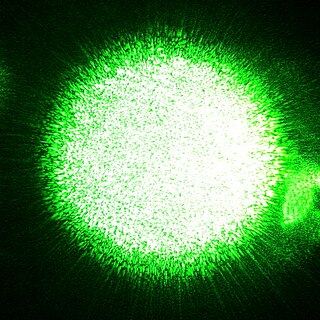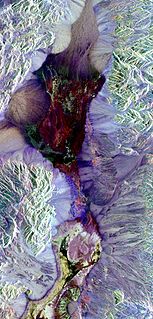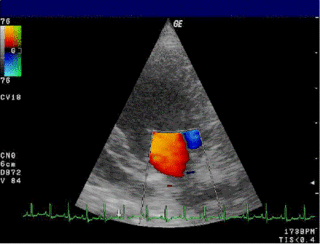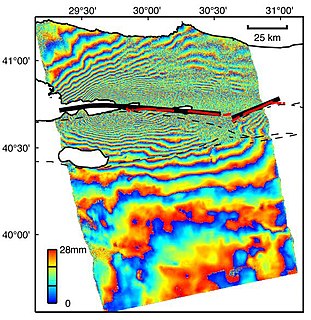Speckle is a granular 'noise' that inherently exists in and degrades the quality of the active radar, synthetic aperture radar (SAR), medical ultrasound and optical coherence tomography images.

Radar is a detection system that uses radio waves to determine the range, angle, or velocity of objects. It can be used to detect aircraft, ships, spacecraft, guided missiles, motor vehicles, weather formations, and terrain. A radar system consists of a transmitter producing electromagnetic waves in the radio or microwaves domain, a transmitting antenna, a receiving antenna and a receiver and processor to determine properties of the object(s). Radio waves from the transmitter reflect off the object and return to the receiver, giving information about the object's location and speed.

Medical ultrasound is a diagnostic imaging technique based on the application of ultrasound. It is used to create an image of internal body structures such as tendons, muscles, joints, blood vessels, and internal organs. Its aim is often to find a source of a disease or to exclude pathology. The practice of examining pregnant women using ultrasound is called obstetric ultrasound, and was an early development and application of clinical ultrasonography.

Optical coherence tomography (OCT) is an imaging technique that uses low-coherence light to capture micrometer-resolution, two- and three-dimensional images from within optical scattering media. It is used for medical imaging and industrial nondestructive testing (NDT). Optical coherence tomography is based on low-coherence interferometry, typically employing near-infrared light. The use of relatively long wavelength light allows it to penetrate into the scattering medium. Confocal microscopy, another optical technique, typically penetrates less deeply into the sample but with higher resolution.
Contents
The vast majority of surfaces, synthetic or natural, are extremely rough on the scale of the wavelength. Images obtained from these surfaces by coherent imaging systems such as laser, SAR, and ultrasound suffer from a common phenomenon called speckle. Speckle, in both cases, is primarily due to the interference of the returning wave at the transducer aperture. The origin of this noise is seen if we model our reflectivity function as an array of scatterers. Because of the finite resolution, at any time we are receiving from a distribution of scatterers within the resolution cell. These scattered signals add coherently; that is, they add constructively and destructively depending on the relative phases of each scattered waveform. Speckle noise results from these patterns of constructive and destructive interference shown as bright and dark dots in the image [1]
Speckle noise in conventional radar results from random fluctuations in the return signal from an object that is no bigger than a single image-processing element. It increases the mean grey level of a local area. [2]
Speckle noise in SAR is generally serious, causing difficulties for image interpretation. [2] [3] It is caused by coherent processing of backscattered signals from multiple distributed targets. In SAR oceanography, for example, speckle noise is caused by signals from elementary scatterers, the gravity-capillary ripples, and manifests as a pedestal image, beneath the image of the sea waves. [4] [5]

A capillary wave is a wave traveling along the phase boundary of a fluid, whose dynamics and phase velocity are dominated by the effects of surface tension.
The speckle can also represent some useful information, particularly when it is linked to the laser speckle and to the dynamic speckle phenomenon, where the changes of the speckle pattern, in time, can be a measurement of the surface's activity.

In physics, dynamic speckle is a result of the temporal evolution of a speckle pattern where variations in the scattering elements responsible for the formation of the interference pattern in the static situation produce the changes that are seen in the speckle pattern, where its grains change their intensity as well as their shape along time. One easy to observe example is milk: place some milk in a teaspoon and observe the surface in direct sunlight. You will see a "dancing" pattern of coloured points. Where the milk dries on the spoon at the edge, the speckle is seen to be static. This is direct evidence of the thermal motion of atoms, which cause the Brownian motion of the colloidal particles in the milk, which in turn results in the dynamic speckle visible to the naked eye.

A speckle pattern is an intensity pattern produced by the mutual interference of a set of wavefronts. This phenomenon has been investigated by scientists since the time of Newton, but speckles have come into prominence since the invention of the laser and have now found a variety of applications. The term speckle pattern is also commonly used in the experimental mechanics community to describe the pattern of physical speckles on a surface which is useful for measuring displacement fields via digital image correlation.








